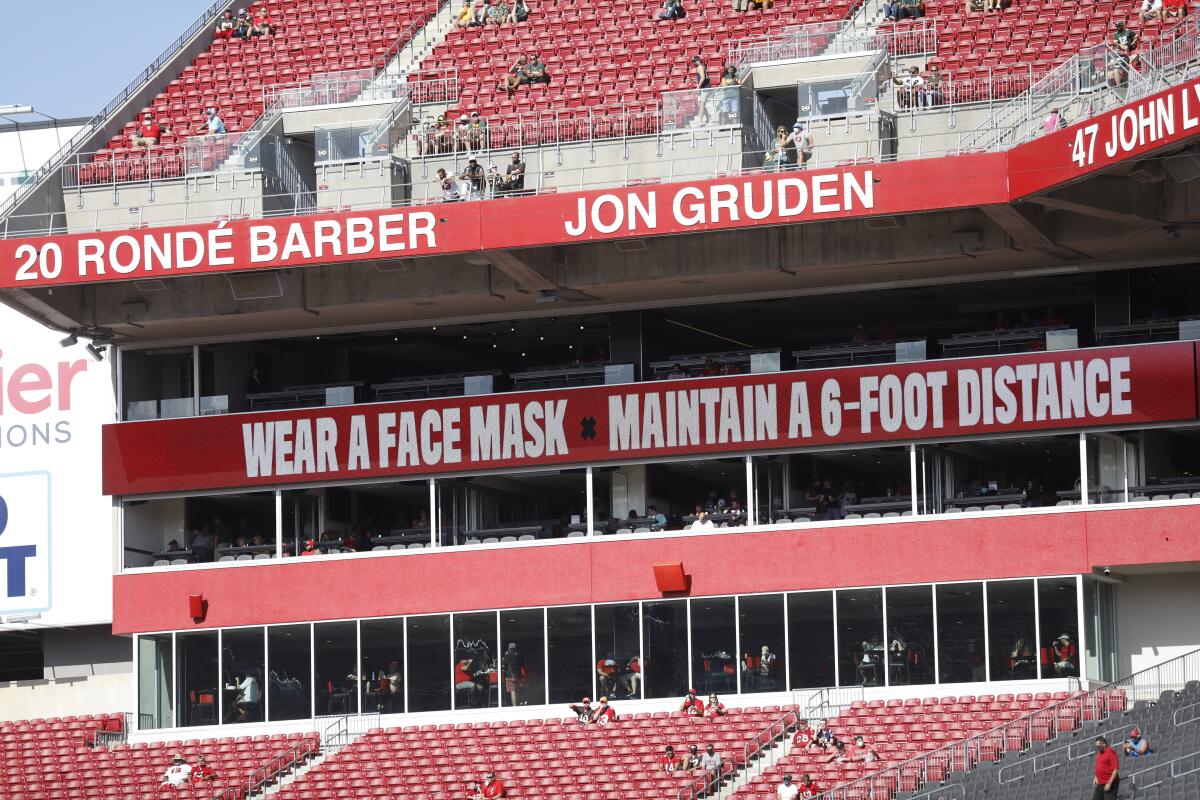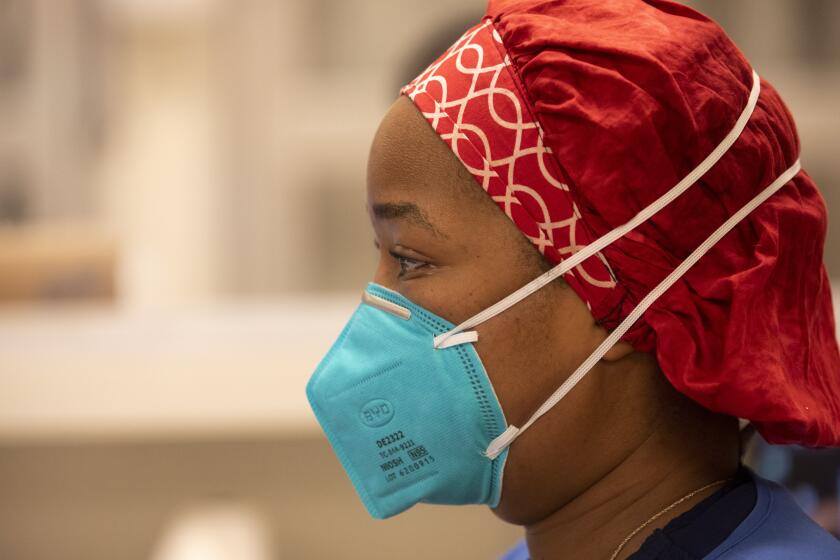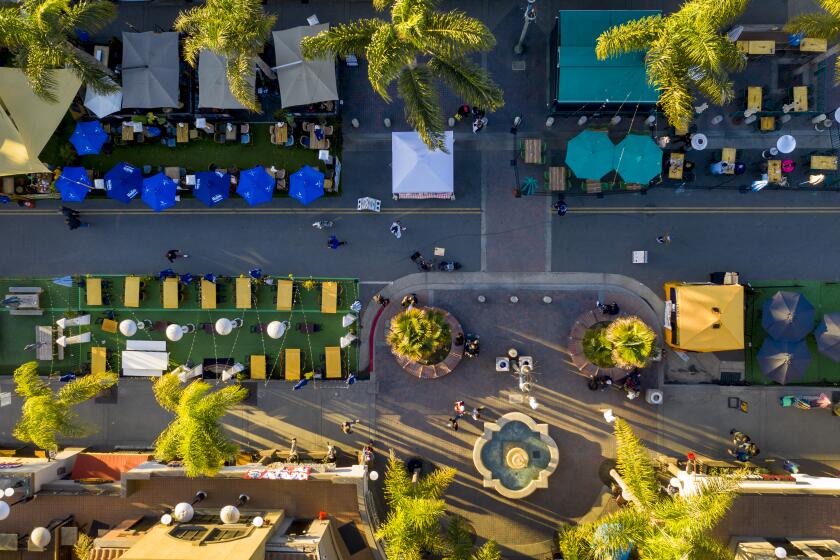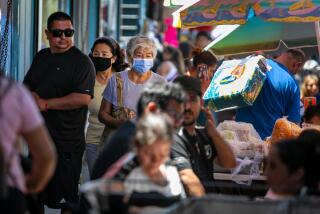Super Bowl, outdoor dining will be big tests of L.A.’s COVID-19 progress

With coronavirus cases and hospitalizations continuing to decline, officials are worrying about the next potential super spreader event: the Super Bowl.
Los Angeles County and California have managed to bend the curve after a deadly fall and winter surge in COVID-19, but the football championship is one of several concerns. Outdoor dining is expected to be allowed to resume at restaurants as early as Friday, the last of several stay-at-home restrictions to be lifted this week.
L.A. Mayor Eric Garcetti on Thursday urged people to keep up their guard and limit exposure to the virus.
“It’s about minimizing risk,” Garcetti said during an evening news briefing. Even as COVID-19 hospitalizations have fallen from a peak of 8,098 on Jan. 5 to 5,855 on Wednesday, the number is still far higher than it was in early October, when fewer than 700 COVID-19 patients were in the hospital.
Said the mayor: “Progress is very fragile.”
L.A. County’s average daily number of cases has fallen over the last two weeks, from about 15,100 cases a day for the weeklong period that ended Jan. 13 to about 7,400 cases now. Daily COVID-19 deaths are expected to remain high for the next couple of weeks; on Thursday, 212 deaths were recorded. L.A. County is averaging 209 deaths a day over the last week, down from an average of 241 deaths a day for the seven-day period that ended Jan. 14.
Garcetti urged people to continue wearing masks when not eating or drinking, and to exercise caution when meeting or gathering with people outside their household.
Especially for the Super Bowl. The Tampa Bay Buccaneers and Kansas City Chiefs take the field in Tampa, Fla., on Feb. 7, and officials fear big social gatherings such as the holiday events will push another winter surge.
“It will be tragic if the Super Bowl becomes a super-spreader of coronavirus,” county Public Health Director Barbara Ferrer said this week. She urged restaurants, in reopening outdoor dining areas, to not repeat the mistakes in the run-up to the World Series and NBA Finals, when crowds of packed fans crammed into outdoor dining patios are believed to be a major factor in the deadliest surge of the pandemic in L.A. County.
More than 9,000 COVID-19 deaths have been reported in L.A. County since Nov. 1, more than half of the county’s cumulative COVID-19 death toll of 16,127.
L.A. avoided a New York-level COVID-19 hospital meltdown as conditions improve
County health officials have long pointed to gatherings held among people from different households as a primary driver of coronavirus transmission. The risk is heightened in crowded settings; when people aren’t wearing masks; and when they’re chanting, singing or shouting — because doing so can propel the respiratory aerosols and droplets that carry the virus even greater distances.
That’s why health officials were alarmed by the celebrations, both impromptu and planned, held to mark the championship triumphs in the fall of the Lakers and Dodgers, and why a typically huge social event such as the Super Bowl is cause for concern.
An uptick in transmission could slow or halt the county’s progress toward wider reopenings, such as the reopening of more elementary schools, or refuel the now-fading surge.
“Every person and every business must continue to take every precaution every day to prevent transmission,” Ferrer said. “It’s really up to us whether we can sustain these reopenings without jeopardizing each other’s health and our ability to get more schools to reopen.”
This year, sports fans should “play it safe,” Ferrer said. “Don’t organize a party at home. Don’t go to a Super Bowl party.”
Here is what you can do — and what you should not do — as COVID-19 restrictions are eased in Los Angeles County.
For the first time in two months, L.A. County this week officially allowed the resumption of private gatherings, so long as they’re held outdoors, attended by members of no more than three households and with no more than 15 people.
But the relaxation of the ban on get-togethers, Ferrer said, “is meant to only allow for a household to form a small, stable social group with one or two other households, so that you can get together occasionally — always outdoors, always keeping six feet of distance and always with no more than 15 people.”
“It just doesn’t work,” she said, “if every night people gather with a different group of folks to have small parties.”
An increase in transmission, officials warn, will kick off a domino effect. More people being infected means more people will be hospitalized with COVID-19 in the weeks ahead. Some of those people will eventually require treatment in an intensive care unit, and some will die of the disease.
“We cannot let this happen,” said Dr. Christina Ghaly, L.A. County’s director of health services. “We can’t let the current high number of COVID patients still in the hospital become normal to us. It is simply not sustainable.”
Garcetti, who turns 50 next week, received his first dose of the COVID-19 vaccine last week. He is not in L.A. County’s designated groups of people who are getting the vaccine — he’s not 65 years or older nor a healthcare worker — but got the first dose on advice of medical staff after he spent five days at Dodger Stadium helping with the vaccination effort.
“There was strong medical advice,” Garcetti said, that he get the shot, just like anyone else working at the mass vaccination site, “to minimize risk to the folks I’m interacting with.”
Garcetti said he felt mild soreness in his arm the day after getting the shot and nothing else after that. “I was able to continue working,” Garcetti said.
He urged people to get the shot when they have the opportunity to do so. “When your time comes, please take advantage of that. Get the vaccine.”
The vaccine has proved to be quite effective among L.A.’s firefighters. About 60% of the city’s firefighters had been vaccinated as of the end of last week, and the number of firefighters testing positive for the virus has dropped significantly.
Times staff writers Dakota Smith and Ben Welsh contributed to this report.
More to Read
Sign up for Essential California
The most important California stories and recommendations in your inbox every morning.
You may occasionally receive promotional content from the Los Angeles Times.














